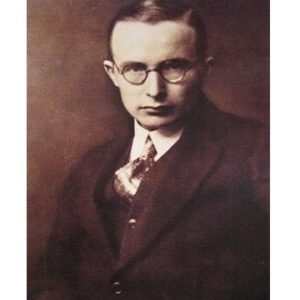Uuno Kailas was a popular Finnish poet during the interwar period. He lived a short and sad life, never achieving the fame he deserved during his lifetime, and died in poverty, battling mental illness and disease. Despite his tragically short life—he died just days before his 32nd birthday—he wrote such moving poetry that he was immortalized in the annals of literature. Death, darkness, burden, and illness recurred in his poetry, serving as a stark reminder of the era he lived in, which was marked by escalating political unrest, wars, mass destruction, and a loss of faith in humanity. In his poems, he reflected on the tragedies of his own tragic life. When his mother died in childbirth when he was only two years old, he had a difficult childhood. His free-spirited father was mostly absent from his life, and he was raised by his strict grandmother. He also had mental health issues and was never in good physical shape. Poetry was his only solace in his lonely life, as he was always in a state of mental turmoil. He was a prolific poet who had several collections of poetry published during his lifetime and after his death.
Childhood and Adolescence
Frans Uno Salonen was born on March 29, 1901, in Heinola, Finland, to Eevert Kailanen and Olga (Honkapää) Salonen, into a farming family. When Uuno was two years old, his mother died while giving birth to twins. The twins did not make it.
His father led a bohemian lifestyle and was unconcerned about his son. Uuno was raised in the homes of his grandmother, uncles, and aunts as a child. Maria Fredrika Juhontytär, his grandmother, was a devout Christian
whose values would influence the poet’s future work. He received his early education in Heinola’s schools.
Career of Uuno
In 1919, he took part in the Aunus expedition, a Finnish guerilla raid into Soviet territory. While fighting the enemy, he wrote patriotic poetry that called for national unity. Bruno Schildt, a close friend of his, died during the raid, which had a profound impact on the young poet.
He enrolled at the University of Helsinki in 1920 to study aesthetics and literature history, and stayed there until 1926. He also wrote a lot during his time at university, devoting a lot of his time to literary pursuits.
He translated other people’s works and wrote criticisms of other people’s works in addition to writing poetry. Many of his works were published in the literary magazine ‘Nuori Voima’ and the newspaper ‘Helsingin Sanomat.’
He was influenced by the ideals of expressionism after being exposed to it through some of the works he translated.
‘Tuuli ja tähkä’ (The Wind and the Corn’s Ear) was his first collection of poetry, published in 1922. Although the collection was not a huge hit, Kailas was not dissatisfied. He carried on writing.
From 1923 to 1925, he served in the army, and in 1925, he published his second collection of poetry, ‘Purjehtijat’ (Sailors). German Expressionism was a strong influence on the poems in this collection.
He also drew heavily on Christian and mythological imagery.
He became involved with the ‘Nuoren Voiman Liitto’ literary association, where he met many like-minded writers, including Katri Vala. Even among the more optimistic and enthusiastic poets, however, he was plagued by thoughts of doom, guilt, and melancholy.
‘Silmästä silmään,’ a collection of poems, was published in 1926. (From eye to eye). Because this work was based on themes of eroticism and sensual pleasures, it was not well received by society’s conservatives.
In the late 1920s, he began to have health problems, which included both physical and mental ailments. Suicidal thoughts consumed him, and he had hallucinations. He became preoccupied with images of death as a result of his ill health.
In 1928, he published another collection of poetry, ‘Paljain jaloin’ (On bare feet), and a few years later, in 1931, he published his final collection, ‘Uni ja kuolema’ (Sleep and death). In his final works, he wrote about dreams and death, leading his friends to believe that he was aware of his impending death.
Achievements & Awards
In 1926, 1928, and 1931, he received the State Literary Award three times.
Personal History and Legacy
In 1926, he shared a home with Lyyli Pajunen, with whom he was deeply in love. However, when Lyyli had an abortion, their relationship came to an end. Lyyli also found it difficult to maintain her relationship with him due to his increasing mental instability. In addition, Kailas had issues with her sexuality.
He was depressed and had never been in good physical health. He was hospitalized for schizophrenia in 1929, and he contracted tuberculosis shortly after. On March 22, 1933, he died in Nice, France. His remains were transported to Finland and interred in Helsinki. In 1939, sculptor Yrjö Liipola erected a memorial in his honor.
Estimated Net Worth
Uuno is one of the wealthiest poets and one of the most well-known. Uuno Kailas’ net worth is estimated to be $1.5 million, according to Wikipedia, Forbes, and Business Insider.


